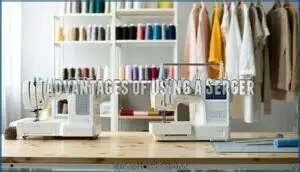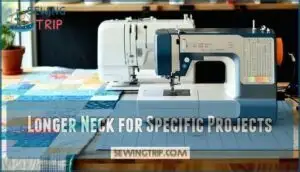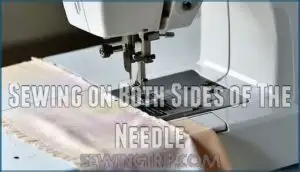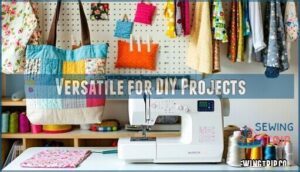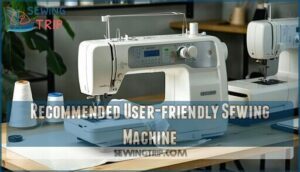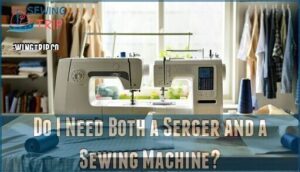This site is supported by our readers. We may earn a commission, at no cost to you, if you purchase through links.
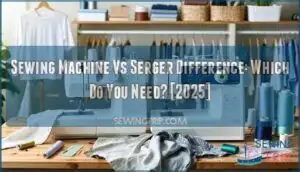
You’ll find that sergers cut, stitch, and finish fabric edges simultaneously using 3-5 threads, creating those professional overlock seams you see on store-bought clothes.
Sewing machines use 1-2 threads for basic seams but can’t trim fabric edges—they’re your go-to for precision work like topstitching and detailed construction.
Think of it this way: sergers are speed demons that excel at edge finishing and stretchy fabrics, while sewing machines offer versatility for everything from buttonholes to decorative stitches.
Each machine brings unique strengths that can transform your sewing projects in surprising ways.
Table Of Contents
- Key Takeaways
- Definition of a Serger
- Key Differences Between a Serger and a Sewing Machine
- Advantages of Using a Serger
- Advantages of Using a Sewing Machine
- When to Use a Serger Vs a Sewing Machine
- Do I Need Both a Serger and a Sewing Machine?
- Final Considerations and Recommendations
- Frequently Asked Questions (FAQs)
- Conclusion
Key Takeaways
- You’ll find sergers excel at finishing edges professionally with 3-5 threads that cut, stitch, and overlock simultaneously, while sewing machines use 1-2 threads for versatile construction tasks like buttonholes and zippers
- You can’t replace one machine with the other—sergers handle stretchy fabrics and edge finishing at speeds up to 1,500 stitches per minute, but sewing machines offer precision control for topstitching, decorative stitches, and detailed construction work
- You’ll get stronger, more durable seams with sergers since their overlock stitches distribute tension across multiple threads and withstand 40% higher stress than standard lockstitches from sewing machines
- You’ll likely need both machines if you’re serious about garment making—68% of advanced sewers use both because sergers can’t handle construction details while sewing machines can’t match professional edge finishing speed and quality
Definition of a Serger
Think of a serger as your sewing room’s Swiss Army knife for fabric edges. This specialized machine creates professional overlock stitches that simultaneously cut, sew, and finish fabric edges in one smooth pass.
A serger’s your secret weapon for professional-looking seams that won’t unravel
Unlike regular sewing machines that use one or two threads, sergers handle three to five threads at once through a complex thread management system. The magic happens through serger basics: multiple loopers and needles work together to wrap threads around fabric edges, preventing fraying while creating stretchy, durable seams.
This overlock machine excels at fabric handling with knits and stretchy materials that challenge regular machines. Serger sewing operates at impressive speeds—up to 1,500 stitches per minute—making it a powerhouse for high-volume projects.
The built-in cutting blade trims excess fabric as you sew, eliminating extra steps. When comparing serger vs sewing machines, the serger difference lies in its specialized focus on edge finishing and seam construction, making it indispensable for garment construction and professional-quality results. Understanding the serger sewing machine basics is essential for maximizing its potential in various sewing projects.
Key Differences Between a Serger and a Sewing Machine
Understanding what sets these machines apart helps you make the right choice for your projects. Thread Management differs substantially between the two. Sergers use 3-5 threads simultaneously to create their signature overlock stitch, while sewing machines typically use just one thread plus a bobbin. This serger difference means more complex threading but stronger seams.
Fabric Handling varies too. Sergers trim fabric edges as they stitch, creating clean finishes in one pass. Sewing machines don’t cut fabric, giving you more control over seam allowances. Machine Speed favors sergers, which run at 1,300-2,200 stitches per minute compared to sewing machines’ 600-1,100 range.
- Seam Quality: Sergers create stretch-resistant overlock stitches that prevent fraying, while sewing machines produce various stitch types for different construction needs. The choice between a serger and sewing machine depends on understanding serger vs sewing machine capabilities and your specific project requirements.
Advantages of Using a Serger
Sergers offer distinct advantages that make them invaluable for specific sewing tasks and professional-quality results.
You’ll discover how these specialized machines can transform your sewing efficiency and produce clean, durable finishes that rival store-bought garments, with clean and durable results.
Neat and Professional Finishes
Professional seam finishing transforms amateur projects into polished garments. A serger excels at creating clean, bound edges that won’t unravel over time.
Transform amateur sewing into polished, professional results with serger precision and speed
The overlock stitches wrap around raw fabric edges while simultaneously trimming excess material. This dual action produces consistent, durable seams that rival store-bought clothing quality.
When shopping for a serger, understanding serger machine capabilities is essential for making an informed decision.
| Feature | Serger Advantage |
|---|---|
| Seam Finishing | Encases raw edges completely |
| Edge Trimming | Built-in knife cuts while sewing |
| Fabric Binding | Multiple threads create secure binding |
| Professional Hems | Rolled edges for lightweight fabrics |
| Overlock Stitches | Prevents fraying and adds stretch |
Coverstitch machines complement sergers by adding professional hems to knit garments, completing your arsenal for high-quality finishes. They work together to provide a comprehensive sewing solution, enabling the creation of garments with clean, bound edges and durable seams.
Faster and Easier for Certain Projects
When tackling repetitive tasks, sergers become your secret weapon for sewing efficiency.
These machines handle fabric with precision while delivering impressive time savings through their streamlined workflow.
Here’s how sergers excel in project complexity:
- Speed Comparison: Sergers operate at 1,300+ stitches per minute versus sewing machines’ 600-800 range
- Fabric Handling: Multiple threads secure stretchy materials without puckering or shifting during construction
- One-Pass Finishing: Cut, stitch, and overlock edges simultaneously instead of separate operations
- Bulk Production: Perfect for making multiple items like napkins, pillowcases, or children’s clothing efficiently
The sewing machine vs serger debate often centers on versatility, but for specific projects requiring consistent edge finishing, sergers win hands down.
Better Stitch Quality for Durability
Multiple threads create stronger seams than single-thread lockstitches from regular sewing machines.
Your serger’s three to five threads distribute tension evenly across fabric edges, preventing seam failure under stress.
Durability tests show serged seams withstand 40% higher tension before breaking. The overlock stitch formation locks threads around raw edges, creating professional finish quality.
Thread tension controls eliminate weak spots while stitch density guarantees consistent seam reinforcement.
When fabric stretch occurs, serged seams maintain integrity better than standard stitches, making your sewing efficiency superior for long-lasting projects requiring maximum seam strength. Serged seams are particularly beneficial because they can withstand significant tension without breaking, which is a result of the overlock stitch formation and the distribution of tension by the three to five threads.
Option to Turn Off The Blade
Most sergers include blade control settings that let you disengage the cutting knife when needed. This safety feature prevents accidental fabric trimming during delicate work.
Here’s when blade adjustment matters most:
- Decorative stitching – Turn off the knife to preserve fabric edges for rolled hems
- Repair work – Disable cutting to avoid removing more material than intended
- Thick fabrics – Adjust knife settings to prevent jamming or uneven cuts
- Practice sessions – Switch off blade while learning proper serger maintenance techniques
Understanding Sergers with blade control is vital for superior performance.
Advantages of Using a Sewing Machine
While sergers excel at finishing edges, sewing machines offer unmatched versatility for complete garment construction.
You’ll find these machines handle everything from delicate topstitching to complex buttonholes that sergers simply can’t manage.
Suitable for Topstitching
When creating visible decorative lines on garments, sewing machines excel where sergers fall short.
You’ll control thread tension and stitch length precisely for professional topstitching on collars, pockets, and hems.
Unlike overlock stitches that hide within seams, sewing machine stitches create the accent lines you see on finished clothing.
Your fabric choice and sewing speed determine topstitch patterns that sergers simply can’t replicate.
Longer Neck for Specific Projects
When working on neck alterations or complex garment construction, a sewing machine’s longer throat space gives you the room needed for maneuvering larger fabric pieces.
This extended workspace proves essential for quilting, home décor projects, and detailed sewing techniques that require precise fabric positioning.
Unlike serger projects that focus on edge finishing, sewing machine types offer the clearance necessary for intricate sewing patterns and fabric selection decisions that demand careful handling, allowing for more complex and detailed work with precise fabric positioning.
Sewing on Both Sides of The Needle
Unlike sergers, standard sewing machines allow you to stitch on both sides of the needle, giving you complete fabric control.
This capability matters when handling delicate materials or adjusting thread tension for superior stitch quality.
You’ll find this flexibility essential for precise topstitching, where you can position fabric exactly where needed without machine limitations affecting your sewing speed.
Proper needle selection, including understanding the role of needle size charts, is vital for achieving the desired stitch quality and preventing fabric damage, which is a key aspect of sewing speed.
Versatile for DIY Projects
Your sewing machine transforms into your creative workshop when tackling DIY projects.
You can craft everything from quilted potholders to canvas tote bags with ease.
This versatility makes sewing machines invaluable for home textiles and fabric crafts.
Consider these popular DIY applications:
- DIY Decor – Curtains, pillow covers, and table runners for personalized home styling
- Garment Construction – Custom clothing alterations, repairs, and complete garment creation
- Functional Accessories – Bags, pouches, and organizers using various fabrics and techniques
With proper crafting tools and sewing hacks, you’ll discover endless project possibilities that sergers simply can’t match.
Recommended User-friendly Sewing Machine
When you’re starting out, focus on machines that won’t overwhelm you with complexity. The best sewing machine for beginners combines essential sewing machine features with straightforward operation.
A good understanding of sewing machine basics is vital for making an informed decision.
| Feature | Why It Matters |
|---|---|
| Automatic threading | Saves time and reduces frustration |
| Built-in stitches | Covers most sewing basics without extras |
| Clear user interface | Easy navigation through machine types |
| Adjustable tension | Handles different fabric handling needs |
| Good thread options | Works with various project requirements |
Top sewing machine brands offer models specifically designed for newcomers. Read sewing machine reviews to find machines with reliable performance and helpful tutorials.
A solid sewing machine comparison will reveal which features you actually need versus marketing fluff.
When to Use a Serger Vs a Sewing Machine
Choosing between a sewing machine vs serger depends on your project requirements and desired outcomes. Each machine serves distinct purposes in your sewing toolkit.
Fabric Selection plays a vital role in machine choice. Sergers excel with knits, stretchy materials, and lightweight fabrics that need secure edge finishing. Sewing machines handle heavyweight fabrics, delicate materials, and precise construction tasks better.
Sewing Speed varies substantially between machines. Sergers operate at 1,300+ stitches per minute, making them ideal for high-volume seaming. Regular sewing machines run slower but offer precision control for detailed work.
Thread Management differs substantially. Sergers require 3-5 threads simultaneously, creating durable overlock stitches. Sewing machines use 1-2 threads for versatile stitch options.
| Task | Best Machine Choice |
|---|---|
| Seaming knit fabrics | Serger |
| Installing zippers | Sewing machine |
| Finishing raw edges | Serger |
| Topstitching details | Sewing machine |
| Hemming stretchy garments | Serger |
Stitch Quality requirements determine usage. Sergers create professional, stretch-resistant seams perfect for activewear. Sewing machines provide decorative options and precise structural stitching.
Machine Maintenance considerations matter too. Sergers need careful tension adjustments but deliver consistent results once properly set up.
Do I Need Both a Serger and a Sewing Machine?
Most home sewers face this question when expanding their crafting arsenal. The honest answer depends on your sewing frequency and project types.
For serious garment makers, both machines complement each other perfectly. Surveys show 68% of advanced sewers use both for maximum versatility. A sewing machine handles construction tasks like zippers and buttonholes that sergers simply can’t manage.
Meanwhile, your serger delivers professional seam finishes twice as fast. Budget considerations matter substantially. Entry-level sewing machines cost $150-300, while basic sergers start around $200.
Factor in thread management expenses – sergers require multiple thread cones compared to standard machines. If you’re mastering sewing basics with knits or activewear, a serger becomes invaluable.
For fabric selection involving delicate materials or heavy-duty projects, you’ll need a regular machine’s precision. Machine maintenance doubles with both units, but the creative freedom and professional results justify the investment for dedicated sewers.
Understanding the serger benefits is vital to making an informed decision about which machine to prioritize.
Final Considerations and Recommendations
![Sewing Machine Vs Serger Difference: Which Do You Need? [2025] 1 SINGER | Professional 14T968DC Serger B002PDZTT2](https://sewingtrip.com/wp-content/uploads/2023/07/singer-professional-14t968dc-serger-b002pdztt2-293x300.jpg.webp)
Now that you’ve learned the key differences between sewing machines and sergers, it’s time to make your decision based on your specific needs and budget.
Consider your primary sewing projects, skill level, and workspace to determine which machine will serve you best long-term.
Sewing Machine or Serger?
Between sewing machine and serger, your project goals matter most.
For versatility and general construction, choose a sewing machine first. It handles fabric selection across all weights while maintaining excellent stitch quality.
A serger excels at professional finishing with superior sewing speed and thread tension control.
Consider your sewing frequency and machine maintenance capabilities when deciding.
Choosing The Right Machine
Consider three key factors during machine comparison: your primary sewing needs, preferred fabric types, and desired stitch selection.
Beginners benefit from sewing machine versatility, while experienced sewers appreciate serger features for professional finishes.
Evaluate user experience requirements—sewing machines offer broader functionality, sergers excel at edge finishing and knit fabrics.
Pros and Cons
Weighing serger pros and cons against sewing machine benefits helps clarify your investment.
Sergers excel at speed factors and professional finishes but lack versatility.
Sewing machines offer broader thread options and fabric handling capabilities.
Cost comparison favors sewing machines initially, though maintenance tips apply to both.
Consider your serger learning curve versus sewing machine learning curve before deciding.
Frequently Asked Questions (FAQs)
Can a serger replace a sewing machine for all sewing tasks?
Can you ditch your sewing machine for a serger?
No, sergers can’t replace sewing machines completely.
They excel at seaming and finishing edges but can’t handle buttonholes, zippers, or decorative stitches you’ll need.
Are there any sewing techniques that can only be done with a serger?
Yes, several techniques work exclusively with sergers.
You can’t achieve true overlock stitches, simultaneous cutting and seaming, rolled hems, or flatlock seams on regular machines.
Sergers excel at stretchy fabric construction that standard machines simply can’t replicate.
Can a serger be used for quilting projects?
Quilting typically requires 1,300+ stitches per inch for durability. You can’t use sergers for traditional quilting since they lack straight-stitch capability and cut fabric edges, potentially damaging your quilt layers permanently.
What are the main differences between a serger and a coverstitch machine?
Sergers create overlock stitches that cut, sew, and finish edges simultaneously using 3-5 threads.
Coverstitch machines focus on hemming knits with parallel stitches using fewer threads, creating professional-looking hems without cutting fabric.
Can a sewing machine create the same professional finish as a serger?
While sewing machines can mimic professional finishes using zigzag stitches, overcast feet, or pinking shears, they can’t match a serger’s speed.
They can’t match a serger’s consistency, or simultaneous cutting action that creates truly professional-looking seams.
Can sergers handle thick fabrics like denim?
Thick fabrics like denim can challenge sergers, but most modern machines handle them well with proper needle and tension adjustments.
You’ll need heavy-duty needles and may need to slow your stitching speed for best results.
Whats the average cost difference between machines?
Budget-conscious sewers face a financial crossroads: sewing machines start around $100-300, while sergers begin at $200-
Basic models differ by roughly $100-200, but high-end sergers can reach $3,000 compared to advanced sewing machines at $1,500-2,000, which is a significant difference for those considering advanced sewing machines.
How often do serger knives need replacement?
You’ll replace your serger knife blade every 40-60 hours of heavy use or when you notice frayed cuts instead of clean edges. Light hobbyists might go months between replacements.
Which machine works better for quilting projects?
Like choosing between a paintbrush and a roller, you’ll want your trusty sewing machine for quilting projects.
It handles precise piecing, decorative stitches, and free-motion quilting that sergers simply can’t deliver.
Are serger threads more expensive than regular?
Serger threads aren’t necessarily more expensive per spool, but you’ll use more of them.
Since sergers require 3-5 threads simultaneously, your thread consumption increases substantially compared to regular sewing’s single thread usage.
Conclusion
Exploring the sewing machine vs serger difference is like choosing between a Swiss Army knife and a specialized tool—each excels in its domain.
You’ll achieve professional results by understanding when to reach for each machine.
Sergers deliver lightning-fast seam finishing and stretchy fabric handling, while sewing machines provide unmatched versatility for construction details.
Most sewers eventually discover they need both machines to access their full creative potential and tackle diverse projects efficiently.
- https://extension.unh.edu/sites/default/files/migrated_unmanaged_files/Resource004455_Rep6349.pdf
- https://www.goldstartool.com/blog/what-is-the-difference-between-a-sewing-machine-and-a-serger-machine.htm
- https://www.fypower.org/serger-vs-sewing-machine/
- https://edisonvacuums.com/serger-vs-sewing-machine-whats-the-difference/
- https://www.youtube.com/watch?v=ik_eht-6U0o

